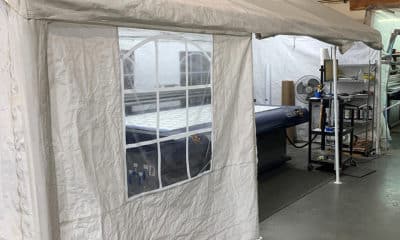PRINT TECHNOLOGY has taken great strides over the past few decades. We no longer simply print on paper. We can print on fabric, metal, wood, and a seemingly endless variety of substrates today. Even 3D printing has taken off in the industry.
The way we print will continue to evolve and change and, with each change, we will have new variables to consider. One consideration that will remain constant is that we need to continue to closely monitor color quality.

(Top) A third-party app that works with Nix devices is the SpeckCheck app for color verification. This solution provides a color verification target that is printed and then measured with the device. (Bottom) The Spectro 1 Pro is a mobile spectrophotometer capable of color matching and visual analysis. It can measure reflectance curves and color data into its dedicated app.
With all the different print processes we have and will develop in the future, color will remain a primary concern. Those of us in color management are working to get verification and assessment tools in the hands of everyone involved in the printing process. Our goal is to make color evaluation accessible and easy to use.
To do that, industry leaders have started to make these solutions more mobile. From apps that can be downloaded directly to your phone or tablet to measurement instruments that can fit in the palm of your hand, mobility has become one of the biggest trends in color management.
Setting Up Color Management: Why It Matters
A good rule of thumb for color management is that consistency is key. Not so long ago, we were under the impression that color management and color quality took place as a product or piece was printed. We understand now that it’s not so. Color management — and ultimately consistent and repeatable color quality overall — begins in the file creation.
Advertisement
When a file is created in design software, there are many choices to be made that likely will affect color.
For instance, in the Adobe programs, default RGB and CMYK working spaces are set to sRGB and U.S. Web Coated SWOP respectively. It is generally recommended that these be changed to Adobe RGB 1998 and Coated GRACoL 2006, both of which are newer profiles with larger color gamuts.
Other settings to consider are rendering intents and whether to honor embedded profiles. These choices can be made under Edit and Color Settings in your Adobe software.
The settings chosen in the file creation and design process should be carried through and mimicked in the RIP and print settings. Testing in live print environments has led us to deduce that when the same settings are used throughout the workflow, we have a better chance at producing better and more accurate color quality.
Therefore, it’s critically important that designers have just as much access to color assessment tools as print operators.
You Can’t Measure Color with Your Eyes
In the print industry, we understand that we can’t describe color with words or assess it accurately with our eyes.
We must use numbers and math to determine, measure, compare, and evaluate colors. Therefore, we need to use a measuring device such as a colorimeter or spectrophotometer.
Advertisement
Measurement instruments generally are used to do one of three things when it comes to color: matching spot or brand colors, verification, and building custom printer profiles. While building profiles is an advanced application, designers and print operators with limited color backgrounds certainly can use today’s user-friendly instruments to assess differences in color swatches and perform quick verifications of color.
In the past, measurement instruments have mostly been large and expensive (in the thousands of dollars range). But there are now many smaller, inexpensive — yet still effective — instruments that can be used in color management.
The Color Muse is an inexpensive colorimeter that touts itself as a mobile color matching tool. It’s not as accurate as a spectrophotometer, so it might not be the best solution for verification.
On the other hand, the Spectro 1 Pro is a mobile spectrophotometer capable of color matching and visual analysis. It can measure reflectance curves and color data into its dedicated app.
Nix Sensor Ltd. has a fleet of instruments ranging from the Nix Minis, which are colorimeters, to the Nix Spectro 2, which is a full-blown spectrophotometer. The Nix devices work with several industry software solutions as well.
The price for these instruments ranges from less than $100 to just over $1,000 and all can be held in the palm of your hand for easy mobility.
Advertisement
But What Do You Do with the Data?
Measuring for measurement’s sake doesn’t do much of anything. Once you have the data provided by the instrument, what do you do with it?
Your instrument needs to be connected to a software solution that defines colors by numerical values and/or maps them out visually. Some instruments have their own dedicated apps, as mentioned above. But there also are other apps that work with the instruments that might be tailored to your specific color-management needs.
The Spectro 1 Pro works with the Spectro by Variable app that is available for both Apple and Android products. While it’s created by the same manufacturer as the Color Muse, it is a spectrophotometer capable of quality control features to compare production samples against standards.
The Nix product line has a dedicated app called Nix Toolkit, which also is available for both Apple and Android. The free version allows you to scan samples to find a close match in your color library. But there’s also a paid version that allows you to match colors to standards recognized throughout the industry (such as Pantone®).
However, if you’re looking for a solution beyond color matching, there are some color verification software solutions that also pair with the Nix products.
Seeing Color is an ICC profile viewer that displays profiles in 3D as color gamuts or as spider plot charts. Using a Nix device, you can measure color to plot against your color gamuts to reveal the best match device values and achieve your best quality printing capability.
Another third-party app that works with Nix devices is the SpeckCheck app for color verification. This solution provides a color verification target that is printed and then measured with the device. You can visually compare the print’s results to industry standards and create your own reference from a set of measurements. SpeckCheck also has a full-feature color library function to validate spot colors.
Are You Ready to Take Color Management Mobile?
Color management is important throughout a product’s workflow. Therefore, you need to take advantage of the many options available as a pairing of measurement devices and software solutions.
Color matching and verification now can be achieved with top-of-the-line but inexpensive and smaller measurement devices that work with a variety of mobile apps.
There’s never been a better time to embrace mobile color and level up your color-quality game.
To view a Mobile Color webinar, see this column in our March-April digimag at bigpicturemag.com/digital.

 VEHICLE WRAPS + GRAPHICS3 weeks ago
VEHICLE WRAPS + GRAPHICS3 weeks ago
 Press Releases3 weeks ago
Press Releases3 weeks ago
 Case Studies3 weeks ago
Case Studies3 weeks ago
 Case Studies1 week ago
Case Studies1 week ago
 Benchmarks3 weeks ago
Benchmarks3 weeks ago
 Press Releases2 months ago
Press Releases2 months ago
 Press Releases3 weeks ago
Press Releases3 weeks ago
 Press Releases2 months ago
Press Releases2 months ago



















